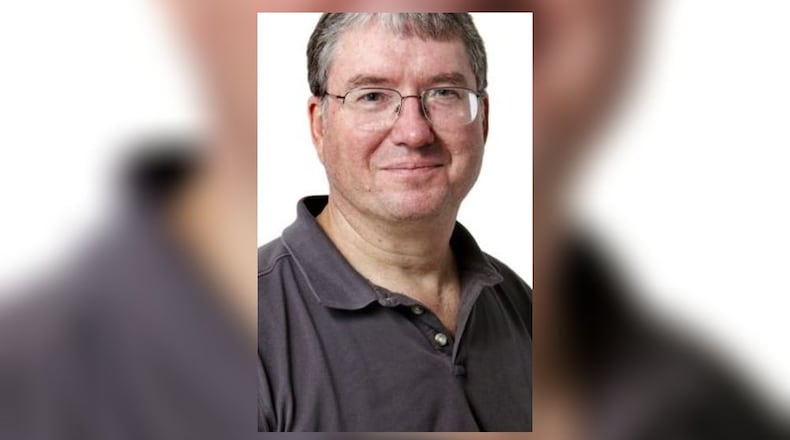It’s an idea I’ve dabbled with for years, aimed at introducing little ones to some fundamentals of science in the kitchen.
The first lesson would, for sure, involve peanut butter, the existence of which is, I believe, the strongest evidence for the existence of God.
“On the first day, he made them, crunchy and smooth. And he said, it is good.”
“And on the second day, he created bread, jelly, honey, apple butter and many other things so the peanut butters, crunchy and smooth, would not be alone. And after tasting it on the bread of life, he said, not only is it good; it is better. And he looked forward to the next day.”
The initial unit would also introduce one of God’s principal prophets, George Washington Carver, who was there at the moment of the big shebang that created the peanut universe. As GWC, as I call him, was African-American, he would lend an element of multi-culturalism to the curriculum, along with a touch of political philosophy.
To digress for a moment, the whole Science for Peanuts thing came the the day moron, here, was trying to clean out a peanut butter jar before tossing it into the recycling bin.
I reasoned that hot water would help melt down the peanut butter and clean out the jar faster than further efforts with a spoon and my by then cramped hand covered with lusciously lick-able peanut butter.
It worked, and, thanks to science, saw and another opportunity to lick lusciously.
To further develop the experiment, I ate another jar of peanut butter and, despite the difficulty I had speaking, told myself that filling the empty half way with hot water, then putting the lid back on and shaking it, would speed the jar-cleaning process. Again, success.
But a thin line of peanut butter continued to cling to the shoulders of the jar.
I then took a longer pause for a snack of prunes before downing a third jar of peanut butter, which I filled up with hot water and soap.
So that the heated chemical molecules would have time to react with the peanut butter, I let the jar sit for a while before emptying out half of the water, then shaking it to arrive at the most advanced scientific achievement of my lifetime: The Stafford Technique for the cleansing of a vessel containing peanut butter, illustrating the limited solubility of peanut butter in water, the thermodynamics of melting and properties of the hydrodynamics of shaken water.
And that was the key element for my personal recipe for disaster, which involved an element of fate.
My wife was using our microwave last week when she noticed a whiff of smoke in the air. After double-checking to see whether I had been cooking (NOT), she asked me see if the microwave might be at fault.
This called for scientific observation.
I first checked to see whether I’d failed to clean spaghetti sauce or left some of my signature stalactites of cheese hanging from the top of the microwave.
That I had not – and that the microwave was still malfunctioning -- brought us to a transformative moment in our relationship: a moment in which I had not been the sole cause of presence of smoke in our house.
The next morning, aware that, deprived of a microwave, I would have to soldier on as had our forebears on the Ohio frontier, I bent over, grunted and fished a glass pot out of the bottom of a cupboard. I then assembled the materials for what was to have been the second lesson on Science for Peanuts: Experiments in Oatmeal, opus 1.
Into a glass cooking pot, I put two parts water, one part rolled oats, raisins and Splenda brown sugar, something I pay dearly for because I’ve convinced myself it’s that much better for me than regular brown sugar. I turned on the electric element, and it all worked out perfectly.
I then tempted fate by making coffee.
Even without the help of our 3-year-old grandson, I managed to grind the beans and find another glass container to fill with water and put on the electric stove to heat.
In observing mode, I noticed that tiny bubbles, uniformly shaped, soon formed in the water on the bottom of the glass container. Some began releasing from the bottom and floating directly to the water’s surface. Others followed, sometimes colliding and joining with those on the surface to form larger bubble, before popping and seeming to disappear.
This was so fascinating, I wrote a note to myself: “Remember to watch paint dry.”
When enough of the bubbly stuff had happened, I removed the glass container from the stove, held it over the sink and began pouring the steaming water into a French press, into which I had placed the coffee grounds.
The experiment came to a dramatic and flamboyant end that taught me the fundamental lesson of the experiment: Don’t boil water over an electric heat source in a quart Pyrex container … moron!
It will explode. And next time it does, you may be holding it directly over your bare feet, where it had been just moments before, instead of over the sink, into which the boiling liquid harmlessly fell.
Although I’m sad announce the suspension of my plans to develop the Science for Peanuts curriculum, I recognize it as a positive step that should allow parents and guardians of America’s children to do something they desperately need to do in era of COVID: sleep more soundly tonight.
My plan for retirement is to stick to peanut butter.
About the Author
